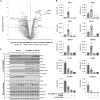NRBP1 pseudokinase binds to and activates the WNK pathway in response to osmotic stress
- PMID: 40668933
- PMCID: PMC12266122
- DOI: 10.1126/sciadv.adv4636
NRBP1 pseudokinase binds to and activates the WNK pathway in response to osmotic stress
Abstract
WNK family kinases are regulated by osmotic stress and control ion homeostasis by activating SPAK and OXSR1 kinases. Using a proximity labeling approach, we found that osmotic stress promotes the association of WNK1 with the NRBP1 pseudokinase and TSC22D2/4 adaptor proteins, results that are confirmed by immunoprecipitation, mass spectrometry, and immunoblotting studies. NRBP1 pseudokinase is closely related to WNK isoforms and contains a RΦ-motif-binding conserved C-terminal (CCT) domain, like the CCT domains in WNKs, SPAK, and OXSR1. Knockdown or knockout of NRBP1 markedly inhibited basal as well as sorbitol-induced activation of WNK1 and downstream components. We demonstrate that recombinant NRBP1 can directly induce the activation of WNK4 in vitro. AlphaFold-3 modeling predicts that WNK1, SPAK, NRBP1, and TSC22D4 form a complex, in which two TSC22D4 RΦ-motifs interact with the CCTL1 domain of WNK1 and the CCT domain of NRBP1. Our data indicate that NRBP1 and likely its close homolog NRBP2 function as an upstream activator of the WNK pathway.
Figures









References
-
- Xu B., English J. M., Wilsbacher J. L., Stippec S., Goldsmith E. J., Cobb M. H., WNK1, a novel mammalian serine/threonine protein kinase lacking the catalytic lysine in subdomain II. J. Biol. Chem. 275, 16795–16801 (2000). - PubMed
-
- Alessi D. R., Zhang J., Khanna A., Hochdorfer T., Shang Y., Kahle K. T., The WNK-SPAK/OSR1 pathway: Master regulator of cation-chloride cotransporters. Sci. Signal. 7, re3 (2014). - PubMed
-
- Xu B. E., Min X., Stippec S., Lee B. H., Goldsmith E. J., Cobb M. H., Regulation of WNK1 by an autoinhibitory domain and autophosphorylation. J. Biol. Chem. 277, 48456–48462 (2002). - PubMed
MeSH terms
Substances
LinkOut - more resources
Full Text Sources

